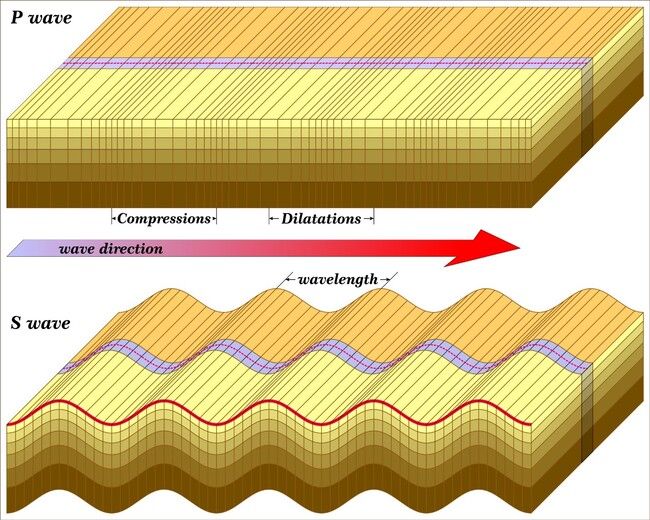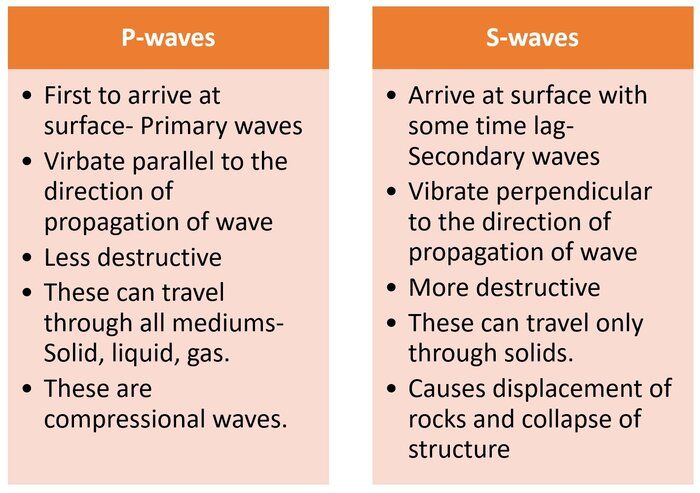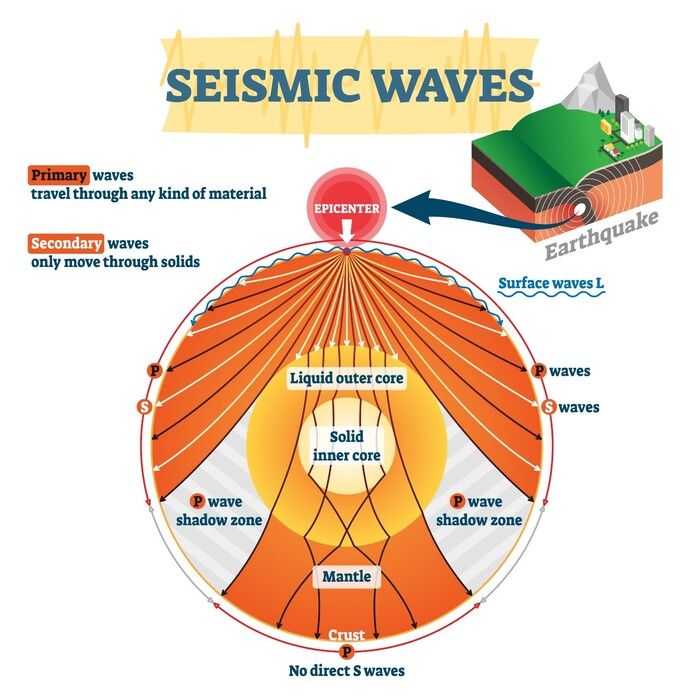Earthquake – Causes, Types and Effects | Shadow zones | P waves and S waves | Mercalli and Ritcher Scale
One of the indirect sources to know more about the Interior of Earth is seismic activity. The study of seismic waves provides complete information regarding the structure of layers of the earth’s interior. In this article, we have discussed about what is an earthquake, causes of earthquake, measurement of seismic activity, types of waves, shadow zone of P waves and S waves and effects of earthquake. This will help you in understanding the next article Internal Structure of Earth.
1. What is an Earthquake?
The shaking of the Earth's surface is called an earthquake. The sudden release of energy into the Earth's lithosphere creates seismic waves, which eventually come to us in the form of vibration. Sometimes the intensity of an earthquake is so weak that it cannot be felt and sometimes it is so severe that there is devastation like 2001 earthquake in Kutch, Gujarat and 2015 earthquake in Nepal.
Epicentre: The point on the Earth’s surface above where the earthquake originated is called epicenter. It is directly above focus. It is the first to experience the waves.
Focus/ Hypocentre: It is the point where energy is released.
2. Causes of Earthquake
Natural forces:
- The motion of tectonic plates is the most common cause of earthquakes.
- Volcanic eruptions are the second leading cause of earthquakes. Often earthquakes occur before or after magma rocks come to Earth with volcanic eruptions.
Artificial forces:
- Large scale mining work in underground mines is another cause of earthquake. Due to the pressure generated within the rocks, the earth usually vibrates.
- Artificial explosions or nuclear tests are also responsible for earthquakes. High intensity explosions such as nuclear explosions are a primary cause of earth tremors.
- Apart from this, the construction of large dams and reservoirs is also another cause of earth tremors at the regional level.
3. Measurement of Earthquake- Mercalli and Ritcher Scale
Earthquake is measured either in magnitude or intensity of shock.
Ritcher Scale measures the magnitude which refers to the energy released during the earthquake. It is expressed in numbers from 0-10.
Mercalli Scale measures the intensity which takes into account the visible damage caused by the Earthquake. Its range varies from 1-12.
Seismograph is an instrument that records the seismic waves reaching the surface.
4. Types of waves
Earthquakes are caused by the energy released through seismic waves. These waves are generally of two types- Body waves and Surface Waves. The velocity of waves changes when they travel through materials having different densities (Denser the material, higher is the velocity).
Body waves are generated when the energy is released at focus. These move in all directions through the earth.
When the body waves interact with surface rocks they generate new waves called surface waves.
The body waves are further classified as:
4.1. P-Waves
These waves are also known as primary waves. These are the first waves to reach surface. These waves are like sound waves. They travel through all three mediums - solid, liquid and gas. These waves have a tendency to vibrate parallel to the direction of wave propagation.

Fig.1: P waves and S waves
4.2. S-Waves
S-waves appear sometime after the P-waves and are called secondary waves. An important feature of these S waves is that they travel only through a solid medium. The vibrational direction of this S wave is perpendicular to the direction of wave propagation, forming crusts and troughs in the direction of their transmission.

Fig.2: Difference between P waves and S waves
The Surface waves can also be divided into two types:
4.3. L-Waves
Also called Love waves. These waves cause horizontal shifting of the earth. These move faster than R waves but slower than body waves. These are confined to the surface of the crust.
4.4. R-Waves
Also known as Rayleigh waves. These follow an elliptical motion. These cause ground to shake in an elliptical pattern. It includes both longitudinal and transverse motions that fades out exponentially with increasing distance from the surface.
5. Shadow zone of P waves and S waves
Shadow Zone is the area of the Earth that does not record any kind of waves. For both P and S waves, a zone between 105° to 145° is a shadow zone. The zone beyond 105° does not record S-waves. The shadow zone of P waves is smaller than that of S-waves.

Fig.3: Shadow zones of P-waves and S-waves
6. Types of Earthquake
The various types of earthquakes are listed below:
- Tectonic Earthquakes: These are the most common ones that are generated due to sliding of rocks along the fault plane.
- Volcanic Earthquakes: These types of earthquakes occur in areas of active volcanoes.
- Collapse Earthquakes: These occur in the areas of intense mining activity where when the roofs of underground mines collapse, it causes tremors.
- Explosion Earthquakes: These occur when tremors are caused due to the explosion of chemical or nuclear devices.
- Reservoir induced Earthquakes: These occur in the areas of large reservoirs.
7. Effects of Earthquake
Earthquake is a natural disaster that has immediate effects. The hazardous effects of the earthquake are listed below:
- Shaking of the ground
- Differential ground settlement
- Landslide- It is the movement of mass of rock, debris or earth down the slope.
- Soil Liquefaction- Due to earthquake, the stiffness and strength of the soil is reduced and it starts behaving like a viscous liquid.
- Ground lurching
- Avalanche- It is a rapid flow of snow down the slope of a mountain or hill.
- Displacement of ground
- Floods due to dam failure
- Fires
- Collapse of structures
- Tsunami- These are the waves generated by tremors when the epicenter of the earthquake is below oceanic waters and magnitude is very high (> 5 on Ritcher scale).
- Damage to Life and property
The Ring of Fire zone i.e. the Circum Pacific Belt is the zone of earthquake that surrounds the pacific ocean. About 90% of the earthquakes in the world occur in the belt. Alpide Belt that extends from Mediterranean region towards Turkey, Iran and India is the second most seismic region in the world.
Need to Know Facts about Earthquake
- The largest recorded earthquake in the world occured in Chile in 1960. Its magnitude was 9.5.
- The average rate of motion across the San Andreas Fault Zone during the last 3 millions years is 2 inches/ year.
- The first pendulum seismoscope was developed in 1751.
- Moonquakes i.e. earthquakes on the moon also occur but their frequency of occurrence and magnitude is less.
- The deadliest recorded earthquake in the world occured in 1556 in China.
- Most of the earthquake waves have a frequency less than 20 Hz and therefore, could not be detected by humans.




 Latest
Latest 



Comments